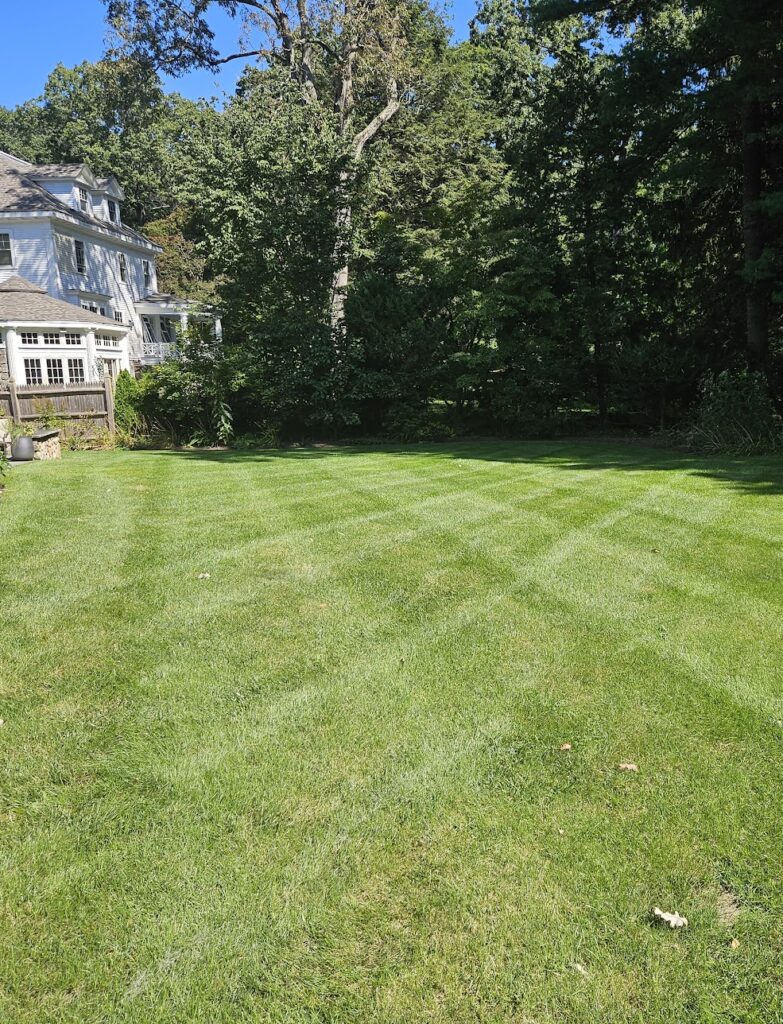Lawn Care
Our lawn care programs are essential for maintaining a lush, vibrant, and, most importantly, healthy lawn. A well-cared-for lawn enhances the beauty of your property while promoting a thriving outdoor environment. With specialized services like fertilizer application, core aeration, and over-seeding, we ensure that your lawn stays free of weeds, fungi, and other destructive pests that can compromise its health and appearance.
Our approach focuses on using organic fertilizers that promote sustainable growth, while also catering to clients who prefer a completely chemical-free lawn care solution. These programs are designed to not only enhance the visual appeal of your lawn but also strengthen its resilience against common challenges, ensuring long-term health and vitality.
7 Step Prgrogram
- Early Spring: Balanced fertilizer.
- Pre-emergent crabgrass herbicide (option)
- Mid Spring: Slow-release fertilizer.
- Grub Control (option)
- Early Summer: Slow-release fertilizer.
- Pre-emergent broadleaf Control (option)
- Early Fall: Balanced Fertilizer.
- Pre-emergent broadleaf Control (option)
- Late Fall: Balanced Fertilizer for
- winterizing
- Late Fall: Lime, to maintain
neutral (pH) level
Fertilization
Soil nutrients are essential part of plant growth.
Our fertilization programs are all based on that same concept, to stabilize your lawn with Nitrogen (N), Phosphorus (P), and Potassium (K) (NPK) to achieve a healthy, better looking lawn. We offer many lawn programs tailored to your particular needs. This includes organic or synthetic fertilizer with or without integrated Pest Management (IPM).
It’s important to understand that placing the wrong chemicals in the wrong place can be a recipe for disaster. This is why we urge all of our clients to do a soil test before making any drastic changes to their lawns.
Pest – “Any living thing that has an undesirable impact that is important to us” – In our case (Insects, Plant/Weeds, and Microorganisms/Fungi)
Contact us now to get on our schedule !
Seeding
Seeding is a very important step to maintain or make your lawn look greener than ever. The more grass you have, the greener your lawn will look. Even though most people think this, people don’t realize how important is to have a think, healthy lawn. The thicker the lawn, the more shade it produces to the ground, which is a very important step to stop weeds from germinating. Weeds like crabgrass need a lot of sun and heat to germinate, but with thick grass, the germination percentage is highly reduced. Also the more grass you have, the less space weeds have to germinate.
There are many types of seeds to chose from, but the most important aspect of the job is to place the right seed on the right spot.
Overseeding
Over-seeding is the process of seeding a lawn with a spreader that causes some seed to ground contact. This is the cheapest way to seed your lawn, but it will do the job as long as it’s done the right way. Two things are important, first, the lawn must be really short to increase soil to seed contact, second, there cannot be too much thatch on the ground, because it will cause shade (which will not allow sunlight to help germination) and it will limit seed to soil contact.
Slit-Seeding
Slit-Seeding is the process of seeding a lawn with a slit-seeder. A slit-seeder is a machine that has many knives that produce small trenches for seed to fall into and germinate. These knives also de-thatch the lawn allowing nutrients and sunlight to reach soil level. Even though it’s a more expensive way to go, it gives a higher rate of germination for the seeds placed and will give you a better result.

De-Thatching
De-Thatching is the process of removing that from the lawn to promote greener and healthier lawns. This process is done when there is at least 1/2 inch of Thatch. Thatch can prevent the growth and health of grass or turf. Removing the thatch helps the grass by encouraging it to thicken up and will also makes it stronger and less exposed to disease. Reducing thatch levels increases the levels of water, air and nutrients that can get through to the root zone of the grass plants. Significant thatch problems in lawns can cause diseases and can encourage moss to grow in the areas where grass has died.
Thatch– is a build-up of organic matter which can include dead grass, leaves, stems, stolons, rhizomes, overcrowded grass roots and lateral weed growth.
Core-Aerating
As any of the steps above, Aerating is a must for a healthy lawn. Core-Aerating allows us to make holes on the ground to promote air to puncture and other key element to puncture into the ground and allow the root system of the lawn to receive these key element.This process allows the root systems to grow stronger and healthier.
Contact
Message Us
First Name
Last Name
Message
Submitting Form
Wait while we submit your form.